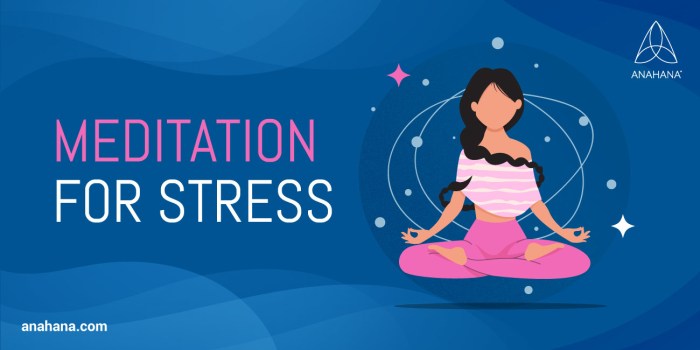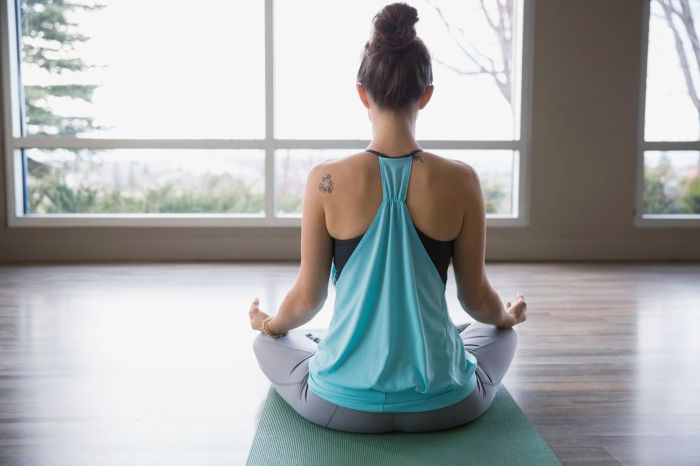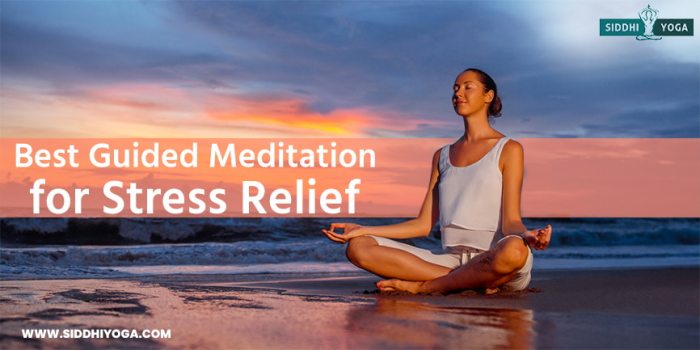7 Ways to Use Meditation for Stress Management offers a comprehensive guide to incorporating meditation into your daily routine to combat stress and promote overall well-being. From different techniques to helpful tips and tools, this article dives into the world of meditation for effective stress relief.
Introduction to Meditation

Meditation, in the context of stress management, is a practice that involves focusing the mind and eliminating chaotic thoughts to achieve a state of peace and tranquility. It is a powerful tool that can help individuals cope with stress, anxiety, and other mental health challenges.
Benefits of Incorporating Meditation
- Reduces stress levels: Meditation has been shown to lower cortisol levels, the hormone associated with stress, leading to a calmer mind and body.
- Improves focus and concentration: By training the mind to stay present and focused, meditation can enhance cognitive abilities and productivity.
- Promotes emotional well-being: Regular meditation practice can help individuals better regulate their emotions and respond to challenging situations with greater resilience.
- Enhances self-awareness: Through meditation, individuals can develop a deeper understanding of themselves, their thoughts, and emotions, leading to increased self-awareness and self-acceptance.
Historical Background of Meditation
Meditation has been practiced for thousands of years, with roots in ancient Eastern traditions such as Hinduism and Buddhism. These practices were originally developed to achieve spiritual enlightenment and self-realization. Over time, meditation techniques have evolved and spread to various cultures around the world, becoming a popular tool for promoting mental health and well-being.
Types of Meditation Techniques
Meditation offers a variety of techniques that can help manage stress and promote relaxation. Let’s explore some of the different types of meditation techniques that are particularly effective in combating stress.
Mindfulness Meditation, 7 Ways to Use Meditation for Stress Management
- Mindfulness meditation involves focusing on the present moment without judgment. It helps in increasing self-awareness and reducing stress by allowing you to acknowledge and release negative thoughts and emotions.
- Practicing mindfulness meditation regularly can lead to improved mental clarity, emotional stability, and overall well-being.
Mantra Meditation
- Mantra meditation involves repeating a calming word, phrase, or sound to quiet the mind and promote relaxation. This technique helps in redirecting focus from stressful thoughts to a soothing mantra.
- Compared to mindfulness meditation, mantra meditation provides a more structured approach to calming the mind and reducing stress through the repetitive nature of the chosen mantra.
Visualization Techniques
- Visualization techniques involve creating mental images of peaceful and relaxing scenes to calm the mind and body. By visualizing serene environments, such as a beach or a forest, you can reduce stress levels and promote a sense of inner peace.
- Visualization techniques are particularly effective in reducing stress through meditation as they engage the mind in a positive and calming way, helping to alleviate tension and anxiety.
Setting Up a Meditation Practice

Meditation can be a powerful tool for managing stress, but creating the right environment is key to maximizing its benefits. Here’s a step-by-step guide to help you set up a conducive space for your meditation practice.
Creating a Peaceful Environment
- Find a quiet and clutter-free area in your home where you can sit comfortably without distractions.
- Consider using cushions or a meditation bench to support your posture and make sitting for longer periods more comfortable.
- Add elements that help you relax, like candles, essential oils, or calming music, to enhance the atmosphere.
Finding the Right Time to Meditate
- Experiment with different times of the day to see when you feel most relaxed and focused. Some people prefer meditating in the morning to start their day on a calm note, while others find it beneficial to unwind in the evening.
- Choose a time when you’re less likely to be interrupted, whether it’s early in the morning before others wake up or in the evening after everyone has gone to bed.
Consistency is Key
- Commit to a regular meditation schedule to experience the full benefits of stress relief. Consistency can help you build a habit and make meditation a natural part of your daily routine.
- Even if you can only spare a few minutes each day, make an effort to practice meditation consistently. Short, daily sessions can be just as effective as longer ones done less frequently.
Breathing Exercises in Meditation

Breathing exercises play a crucial role in stress management through meditation by helping to calm the mind and body, reduce anxiety, and increase focus and clarity.
Diaphragmatic Breathing
- Also known as deep belly breathing, diaphragmatic breathing involves inhaling deeply through the nose, allowing the belly to rise, and exhaling slowly through the mouth, allowing the belly to fall.
- This technique helps activate the body’s relaxation response, reducing the production of stress hormones and promoting a sense of calm.
Box Breathing
- Box breathing is a simple technique that involves inhaling for a count of four, holding the breath for a count of four, exhaling for a count of four, and holding the breath again for a count of four, creating a square or “box” pattern.
- This method helps regulate breathing, increase oxygen flow, and promote relaxation, making it an effective tool for managing stress and anxiety.
Benefits of Controlled Breathing
- Controlled breathing techniques can help reduce the symptoms of stress and anxiety by calming the nervous system, lowering heart rate, and promoting a sense of well-being.
- Practicing deep breathing exercises regularly can improve focus, concentration, and overall mental clarity, enhancing the benefits of meditation for stress management.
Body Scan Meditation
Body scan meditation is a mindfulness practice that involves systematically focusing on different parts of the body to bring awareness to sensations, tension, and relaxation. This technique plays a crucial role in reducing stress by promoting physical and mental relaxation through increased body awareness.
Process of Body Scan Meditation
- Find a comfortable position either sitting or lying down.
- Start by bringing your attention to your breath, allowing yourself to relax.
- Begin scanning your body from head to toe or vice versa, noticing any areas of tension or discomfort.
- As you focus on each body part, consciously release any tension you may be holding.
- Continue the scan until you have brought awareness to every part of your body.
Impact on Physical and Mental Relaxation
- Body scan meditation helps to release physical tension and promote relaxation in the muscles.
- By increasing body awareness, this practice can also help in identifying and reducing stress triggers.
- Regular practice of body scan meditation can lead to improved sleep quality and overall well-being.
Personal Experiences with Body Scan Meditation
“I have found that incorporating body scan meditation into my daily routine has significantly reduced my stress levels. It allows me to unwind and let go of any built-up tension, helping me feel more relaxed and centered.”
“Through body scan meditation, I have learned to listen to my body and address areas of discomfort, leading to a greater sense of calmness and clarity in my mind.”
Using Meditation Apps and Tools

When it comes to managing stress through meditation, technology can be a helpful ally. There are various meditation apps and tools available that can assist you in your mindfulness journey. Let’s explore some popular options and how they can cater to your stress-relief needs.
Popular Meditation Apps and Tools
- Headspace: Known for its guided meditations and mindfulness exercises, Headspace offers a variety of programs to help reduce stress and anxiety.
- Calm: With soothing sounds and meditation sessions for sleep, anxiety, and stress relief, Calm is a popular choice for those looking to unwind.
- Insight Timer: This app provides a wide range of guided meditations, music tracks, and talks from meditation teachers around the world.
Comparing Features of Different Meditation Apps
- Headspace focuses on structured programs for specific needs, while Calm offers a more flexible approach with a variety of meditation options.
- Insight Timer stands out for its community aspect, allowing users to connect with others and join live meditation sessions.
Pros and Cons of Using Technology for Meditation
| Pros | Cons |
| Convenience of access anytime, anywhere. | Potential distraction from the present moment. |
| Wide range of meditation styles and teachers to choose from. | Lack of personalization compared to in-person guidance. |
| Track progress and stay motivated with built-in features. | Possible dependence on technology for relaxation. |
Integrating Meditation into Daily Life: 7 Ways To Use Meditation For Stress Management

Integrating meditation into your daily routine can greatly enhance your overall well-being and help manage stress effectively. Here are some tips to seamlessly incorporate short meditation sessions into your busy schedule:
Making Time for Meditation
- Start your day with a short meditation session before getting out of bed or during your morning routine.
- Utilize your lunch break or any short breaks during the day to sneak in a quick meditation session.
- Set a reminder on your phone or calendar to schedule regular meditation sessions throughout the day.
Maintaining Mindfulness Throughout the Day
- Practice mindful breathing exercises while commuting to work or doing household chores.
- Take short mindfulness breaks during work hours to refocus and recharge.
- Avoid multitasking and focus on one task at a time with full presence and awareness.
Long-term Benefits of Consistent Meditation Practice
- Improved focus, concentration, and productivity in daily tasks.
- Enhanced emotional regulation and reduced reactivity to stress triggers.
- Greater clarity of mind, increased self-awareness, and overall sense of well-being.
Conclusive Thoughts
In conclusion, practicing meditation through the various techniques, tips, and tools discussed can significantly reduce stress levels and improve mental and physical health. By integrating meditation into your daily life, you can experience long-term benefits and a greater sense of peace and balance.